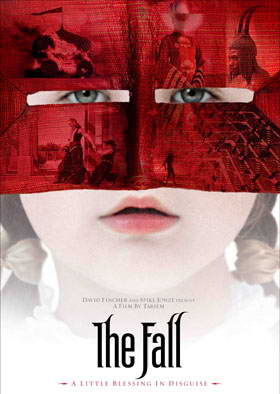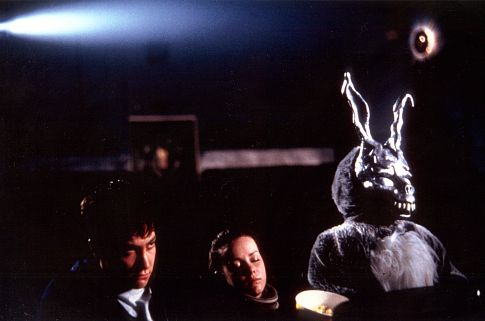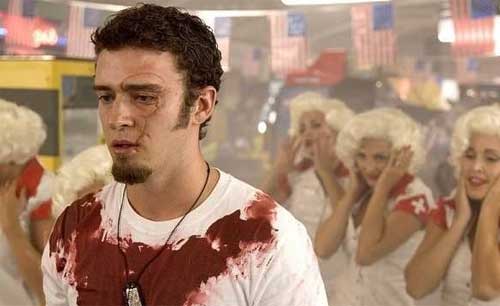
Title: The Fall
Director: Tarsem Singh
Released: 2008
Director: Tarsem Singh
Released: 2008
Staring: Catinca Untaru, Justine Waddell, Lee Pace, Robin Smith, Jeetu Verma, Leo Bill, Marcus Wesley, Julian Bleach, Daniel Caltagirone
Rating: 5/ 5
Rating: 5/ 5
Plot: Roy (Pace) an injured stuntman, forms a friendship with a young girl Alexandria (Untaru), who is recovering from a broken arm, as Roy tells her a story of five mystical hero’s and their quest to kill the oppressive governor Odious (Caltagirone). Though as the story continues the lines between reality and fantasy begin to become all the more blurred.
Review: Some times it amazes me how great films get so overlooked, films which not only challenge their audiencebut at the same time, take them on a journey of lush visuals and fantastic storytelling, as the director challange themselve to give thier audience somthing which they havn't seen before. I guess in a way the same question could also go a long way in explaining why we continue to get sequels to the Scary Movie franchise being churned out on an almost yearly basis.
“The Fall” is certainly one of these movies which sorely deserved to reach a larger audience than it did, upon it’s initial release, especially seeing how it pretty much skipped a cinematic release, suddenly turning up on DVD it would seem , making it only more of a shame, especially seeing how it is certainly a film which deserves to reach a large audience, were now instead it seems to have been left to find it’s own audience, which if there is any justice it will.
Right from the start it is clear that you are watching something special, as Singh skilfully combines slowed down black and white imagery, with his skilful use of Beethoven’s "Symphony No. 7 in A major, Op. 92, II. Allegretto” which here becomes more of a title piece to the film and certainly put it on a par with Clint Mansell’s “Summer Overture” which was most memorably used in “Requiem for a Dream” (2000). The score by Krishna Levy is the perfect accompaniment to the images on screen, not only helping to set the scene, but in some cases helping to emphasise the power of the imagery being shown to us and seems to mis-step though out, even if this sole Beethoven piece seems to dominate over the other pieces of music used thought.
Storywise it’s safe to say that it falls somewhere between the adult fairy tales of Guillermo del Toro and Caro & Jeunet, especially seeing how it contains none of the horrors of the real world, which are fused into the stories of del Toro’s work, while at the same time it doesn’t slip into the more obvious surreal world of Caro & Jeunet whose films such as “The City of lost Children” (1995) are probably best known for such a style of storytelling, instead “The Fall” sits somewhere between the two styles, especially seeing how Singh is keen to keep the two worlds he shows throughout separate, often having the bandit speaking directly at the screen as Roy, when he chooses to take us out of the world of his story.
Roy’s tale of the masked bandit and his mismatched group, is really brought to life by the imagination of Alexandria, who inserts people she see’s around her into the roles of the various characters, making it fun to try and place who each of the characters are in the real world, as she takes the descriptions Roy gives her, applying them to the people she see’s walking around the hospital, even using the x-ray technician, as the basis for how the henchmen of governor Odious look, while characters like the mystic are less obvious as to who they might be in the real world, with Singh only giving us the most subtle of clues as to their identity.
Right from the start it is clear that you are watching something special, as Singh skilfully combines slowed down black and white imagery, with his skilful use of Beethoven’s "Symphony No. 7 in A major, Op. 92, II. Allegretto” which here becomes more of a title piece to the film and certainly put it on a par with Clint Mansell’s “Summer Overture” which was most memorably used in “Requiem for a Dream” (2000). The score by Krishna Levy is the perfect accompaniment to the images on screen, not only helping to set the scene, but in some cases helping to emphasise the power of the imagery being shown to us and seems to mis-step though out, even if this sole Beethoven piece seems to dominate over the other pieces of music used thought.
Storywise it’s safe to say that it falls somewhere between the adult fairy tales of Guillermo del Toro and Caro & Jeunet, especially seeing how it contains none of the horrors of the real world, which are fused into the stories of del Toro’s work, while at the same time it doesn’t slip into the more obvious surreal world of Caro & Jeunet whose films such as “The City of lost Children” (1995) are probably best known for such a style of storytelling, instead “The Fall” sits somewhere between the two styles, especially seeing how Singh is keen to keep the two worlds he shows throughout separate, often having the bandit speaking directly at the screen as Roy, when he chooses to take us out of the world of his story.
Roy’s tale of the masked bandit and his mismatched group, is really brought to life by the imagination of Alexandria, who inserts people she see’s around her into the roles of the various characters, making it fun to try and place who each of the characters are in the real world, as she takes the descriptions Roy gives her, applying them to the people she see’s walking around the hospital, even using the x-ray technician, as the basis for how the henchmen of governor Odious look, while characters like the mystic are less obvious as to who they might be in the real world, with Singh only giving us the most subtle of clues as to their identity.
Pace is on fantastic form here, moving seamlessly from the role of Roy to that of the masked bandit and even though we know that Alexandria is using him as the base for the bandit, it never feels as if you’re just watching Roy, dressed as a bandit, but rather watching Pace as a completely separate character. However as the film progresses and the lines between these two worlds begin to blur, we start seeing more and more of Roy appearing in the character of the bandit, such as his sudden addiction to morphine pills, aswell as the various touches which Alexandria adds herself to the point, were she appears as a character herself, taking on the role of the bandit’s daughter. Still as Roy becomes more suicidal his story becomes all the more darker, while certainly not going as dark as Del Toro’s “Pan’s Labyrinth” (2006) which also featured an equally sudden dark turn, which might not sit well with some viewers, but it is clear that when this appears, that Roy is simply trying to break the connection which he shares with Alexandria. However it does also form some of the more gut wrenching moments of the film, as Singh takes the hatchett to his list of characters.
I suppose the main downside for myself, was with the character of Alexandria, who it is true is Romanian, but her broken English meant that it felt like half the time she was simply improvising her dialogue and really relies often on Roy, to translate to the rest of us what she actually saying. Still her cutesy performance never reaches the level of being overly saturnine sweet, thanks to Singh never allowing the camera to focus for to long on her, without tingeing the scene with some element of darkness, which appears to surround her outside of the safety of Roy’s hospital bed, such as the hypochondriac patient, who Roy shares a hospital ward with, while further driving home the idea of this film being a grown up fairy tale.
Singh who is probably best remembered for “The Cell” (2000), another equally underrated classic, which might have been more popular had it not featured Jennifer Lopez, but still managed to remain highly memorable, thanks to it’s incredible nightmarish imagery, as he took us inside the mind of a serial killer. Thankfully the six year gap since then seems to have not caused him to tone down his mindblowing imagery any less, in fact it seems to only have given him more time in which to think up more breathtaking imagery and by signing up fellow visionary film makers David Fincher & Spike Jonze who both signed as Executive producers (Singh would later provide second unit work for Fincher on “The Curious Case of Benjamin Button (2008)), he has only expanded his canvas and certainly makes the most of it, seeing how the film was shot in 18 different countries, resulting in a film which is nothing short of breath taking and without a hint of CGI to be found, proving to even the most jaded amongst us, that modern film making can still be exciting and interesting, without losing its a accessibility to a mainstream audience, which we have seen over the years happening with a number of equally great foreign films, only for the language barrier to eliminate the majority of their potential audience.
I can only hope that the wait isn't so long for Singh (Or Tarsem as he's now started calling himself) to release his next film, as if his current film making reseme is anything to go off, he could certainly be a director worth watching and I can only hope that his future output remains as exciting and intresting as what we have seen so far.





















I saw The Fall about a year ago, and am still haunted by its story and images. Like in The Cell, the director seems to be playing in the space between the word and the world, and exploring how stories impact reality and vice versa.
ReplyDeleteI really enjoyed your review, and am happy to have stumbled upon your blog. Thank you!
Hi M,
ReplyDeleteGlad you liked the review, it's always nice to know that I'm doing somthing right here :)
"The Cell" I think was one film, which suprised us all, mainly because it was marketed as being a run of mill thriller with a twist, only to be quite arty in places, especially the first trip into the killers mind, which I think lost alot of it's audience. I'm now just looking forward to seeing what he comes up with next.